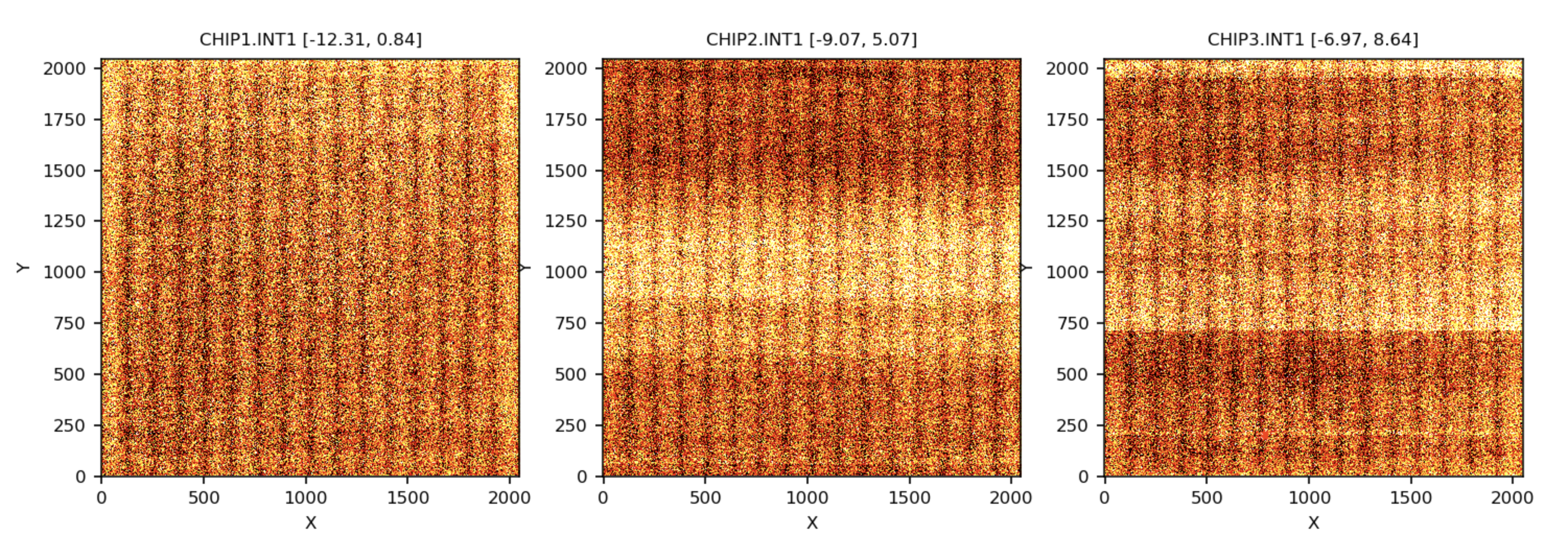 mirror sites:
PL (internal link)
HQ
[?]
mirror sites:
PL (internal link)
HQ
[?]
Quality Control and
Data Processing
|
CRIRES: Dark
Dark frames are taken daily as part of the calibration plan in sets of 3 frames for each DET.SEQ1.DIT value. Darks in specific setups: INS.WLEN.ID=Y1029, J1232, H1559, K2217, L3377, M4266, with short and long DIT are taken every day as health checks. Darks in other setups are only measured when they are triggered by settings of science data observed during the night.
Information about the Quality Control performed utilizing dark frames of the instrument BEFORE the upgrade (before 2021-09) can be found here.  DARK level
DARK level
The median dark level is trended for each detector, as well as for YJHK and LM bands, separately.
The dark_median of the J1228 wavelength setup master darks is tightly scored, with dynamic thresholds following the median average of the current period. The only requirement on the dark current is stability on the calibration timescale.
Group the input frames by different values of DET.SEQ1.DIT and WLEN.ID; Load the images and create the associate error for each of them; Collapse the images; Compute BPM from the collapsed master dark; The median level of master dark is calculated for each detector.  DARK RON
DARK RON
The read-out noise (RON) is trended for each detector, selected setups.
The ron1 is scored, with dynamic thresholds following the median average of the current period. The only requirement on the dark RON is stability on the calibration timescale.
Group the input frames by different values of DET.SEQ1.DIT and WLEN.ID; Load the images and create the associate error for each of them; Collapse the images; Compute BPM from the collapsed master dark; The RON is derived from difference between 2nd and 1st input frame, ron1, and between 3rd and 2nd, ron2) of the master dark; It is calculated for each detector.  DARK NBAD
DARK NBAD
The number of bad pixels (nbad) is trended for each detector, selected setup.
The dark_nbad is scored, with dynamic thresholds following the median average of the current period. The only requirement on the dark number of bad pixels is stability on the calibration timescale.
Group the input frames by different values of DET.SEQ1.DIT and WLEN.ID; Load the images and create the associate error for each of them; Collapse the images; Compute BPM from the collapsed master dark; The number of bad pixels is calculated where the bad pixels are those that deviate from average signal; It is calculated for each detector. |
|||||||||||||||||||||||||||||||||||||||||||||||||||||||||||||||||||||||||||||||||||||||||||||||||||||||||||||||||||||||||||||||||||||||||||||||||||||||||||||||||||||||||||||||||||||||||||||||||||||||||||||||||||||||||||||||||||||||||||||||||||||||||||||||||||||||||||||||||||||||||||||||||||||||||||||||||||||||||||||||||||||||||||||||||||||||||||||||||||||||||||||||||||||||||||||||||||||||||||||||||||||||||||||||||||||||||||||||||||||||||||||||||||||||||||||||||||||||||||||||||||||||||||||||||||||||||||||||||||||||||||||||
| |
||||||||||||||||||||||||||||||||||||||||||||||||||||||||||||||||||||||||||||||||||||||||||||||||||||||||||||||||||||||||||||||||||||||||||||||||||||||||||||||||||||||||||||||||||||||||||||||||||||||||||||||||||||||||||||||||||||||||||||||||||||||||||||||||||||||||||||||||||||||||||||||||||||||||||||||||||||||||||||||||||||||||||||||||||||||||||||||||||||||||||||||||||||||||||||||||||||||||||||||||||||||||||||||||||||||||||||||||||||||||||||||||||||||||||||||||||||||||||||||||||||||||||||||||||||||||||||||||||||||||||||||||
 |
|
|||||||||||||||||||||||||||||||||||||||||||||||||||||||||||||||||||||||||||||||||||||||||||||||||||||||||||||||||||||||||||||||||||||||||||||||||||||||||||||||||||||||||||||||||||||||||||||||||||||||||||||||||||||||||||||||||||||||||||||||||||||||||||||||||||||||||||||||||||||||||||||||||||||||||||||||||||||||||||||||||||||||||||||||||||||||||||||||||||||||||||||||||||||||||||||||||||||||||||||||||||||||||||||||||||||||||||||||||||||||||||||||||||||||||||||||||||||||||||||||||||||||||||||||||||||||||||||||||||||||||||||||
